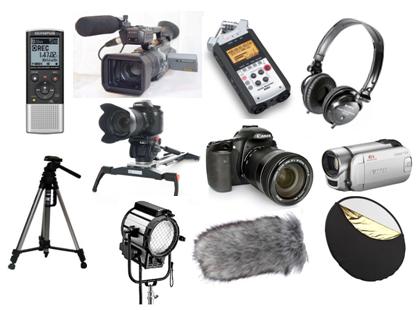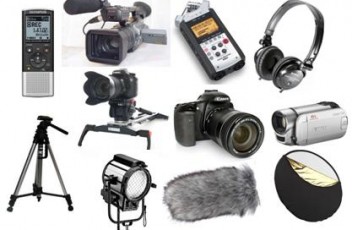
Is there essential filmmaking equipment you may be forgetting before you set out on your shoot? Not only is small crew (or sometimes no crew) filmmaking becoming the lay of the land for many creative professionals producing content in the United States, it’s becoming standard operating procedure for international shoots as well. While shooting The Palette Project, my crew (such as it was) consisted of myself and my colleague, sharing roles of photographer, interviewer, production coordinator and all-around problem solver in chief. Even though a third person in the role of production assistant would have seemed like an unimaginable luxury, the fact of the matter is this: it’s not going to get any easier. Doing more with less is just how it works now. May I refer you to Casey Neistat’s Nike video? Two people going around the world until the money ran out. That’s the template.
Essential filmmaking equipment doesn’t always mean your gear
Working from that baseline, there are actions you must take that will help you make sure the hardest obstacles are at least lower to the ground. We need to talk about he fact that your shoot involves international travel, and that means you have to think globally. What follows from this is that your camera, your production package and most f your gear is secondary when it comes to how you think about “equipment.” Aside from your gear, the essential filmmaking equipment you must have on-hand can, by and large, fit in your pocket. These are items that have very little to do with the actual shooting. These are the things that make travel just part of the background noise for your production.
An extra, unlocked international cell phone
After our cameras, lights and audio equipment, essential filmmaking equipment includes something you may take for granted: your phone. Our phones and tablets may be the most essential pieces of gear we carry overseas. And like Ruffles potato chips, you can’t have just one. However many phones you are taking, add one that isn’t assigned to anyone.
My phone of choice happens to be an iPhone, and Android phones are certainly just as capable for the tasks we use our smartphones for on an international shoot. Whichever phone you use, though, whether it be for record keeping, data entry, field logging, navigation or even as an emergency backup camera, your phone also has a nice additional function in: you can use it to call someone.
Deep in my run bag is an unlocked, quad-band emergency “dumb phone.” It doesn’t have a SIM card, it doesn’t have any apps on it. It’s sole purpose is to be able to make calls anywhere in the world should something happen to my… let’s call it my A-Phone.
And this little guy is worth its weight in gold. Shooting on the Cook Strait as well as the Australian outback and the Pacific Ocean west of Auckland Harbour in 2015, I was more than happy that my ability to contact the outside world was safe and sound should our phones go overboard, overheat or become clogged with dust. A local SIM card is only one drug store away, and while you may never need it, this is an essential pieces of filmmaker equipment the best money you’ll ever spend.
A notarized copy of your passport
Okay, I’m using the word “equipment” loosely here, but essential filmmaking equipment has to include your passport, because you need it wherever you go. The nightmare scenario for any international filmmaker is a lost passport. Getting new identification from the nearest embassy, the lost travel time, the frantic rescheduling. I can’t promise you that none of this will happen if you lose your original passport book or card. However, this is the critical piece of the puzzle to have on hand in order to quickly prove who you are and what’s on file with the Department of State. It taks fifteen minutes to go to a UPS store in the United Staes, or any place that can copy and notarize an official document.
As an aside, this is also a handy piece of paper to have if you find yourself having to file last minute for a work visa in the country where you intend to shoot. Many countries want that notarized copy of your passport, along with loose copies of your passport sized photos, as part of the application process. As far as essential filmmaking equipment goes, It never hurts to have this on hand and, of course, in a very safe place.
A carnet
This it. The big magillah. I am telling you from personal experience that a carnet is the absolute must-have piece of documentation you need when traveling to most countries as part of your international production. If essential filmmaking equipment includes items like voltage converters, extra media cards and bulbs to match the voltage of the country you’re shooting in, it has to include the carnet which proves you bought these items before you left home. you should never plan or shoot a professional film without budgeting for a cornet.
A carnet is an official manifest and seal of every piece of filmmaking equipment you are taking into and out of the country or countries where you’re shooting, from your heaviest camera to the battery that powers it, and everything (and I do mean everything) in between,along with every piece of computer equipment lighting, sound gear and so forth. The $500-$1000 (or more, it depends on the total value of what you’re carrying – ours cost around $700 USD) you will spend for a carnet is more than made up for in both the thousands of dollars of import and export fees/tariffs you won’t pay, because you have official proof that you didn’t buy any of these items in the country where you’re filming, not to mention the hours and hours it would take while customs officials go through every inch of your filmmaking equipment, to itemize your gear and ask you where and when you bought it.
A carnet manifest and seal of approval contains all this information already. When you purchase your carnet and submit your paperwork to get it, you have to fill out an exhaustive list of questions about where and when you bought your filmmaking equipment as well as its m manufacturing country of origin. Yes, it’s time consuming. Trust me when I tell you that it’s worth it.
By the way, if you’re thinking you probably won’t have to deal with customs because the gear you’re using is so minimal or touristy looking, you need to know that when you enter the country or leave the country with a lot of it (like, more than one) customs officials will assume you bought it in their country in order to pay a lower price and don’t want to pay the duty fees. If you’re traveling under a work visa, their eyebrow will perk up even more.You can be subject to duty fees and export taxes that can run into the thousand of dollars, even with that minimal amount of filmmaking equipment.
The above list is hardly an itemization of the most often considered pieces of essential filmmaking equipment, but if you are dedicated to a smooth shoot, it’s a list that can definitely grease the wheels. Travel is exhilarating, yes, but the actual nuts and bolts of travel should be as seamless as possible… or at least solve a few headaches. These items can help you focus on the show itself, not the headaches.
RELATED CONTENT:
GoPro Filmmaking: How To Make It Work For Your Film
